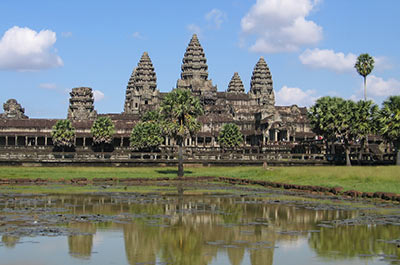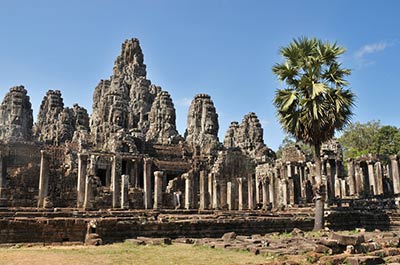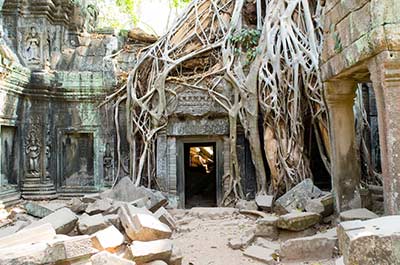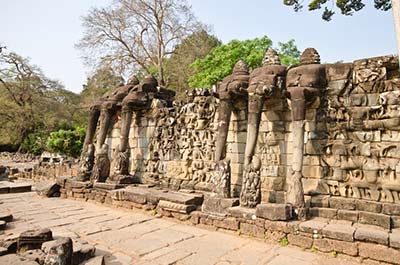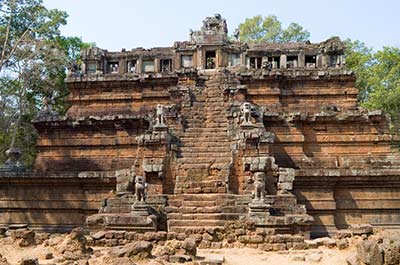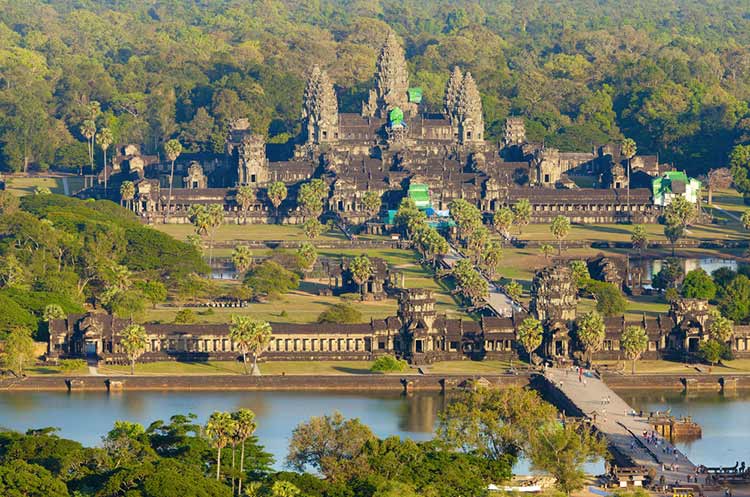
Angkor Archaeological Park
Ruins of one of Asia’s greatest civilizations
Angkor is one of the largest and most important archaeological sites in South East Asia. Many magnificent temples build by the Khmer empire are found in the Angkor Archaeological Park close to present day city Siem Reap in North West Cambodia.
The 400 square kilometer area contains hundreds of monuments, some very well preserved, some merely a pile of stones.
Only the stone temples have survived; the wooden structures, including Royal Palaces and houses of common people have long gone. The Angkor Archaeological Park has been a UNESCO World Heritage Site since 1992.
One of South East Asia’s most powerful empires
Angkor was one of the most powerful empires ever in South East Asia. At the height of its power, the Khmer controlled Cambodia and much of present day Burma, Thailand and Vietnam. A system of ancient roads connected Angkor in the center of the empire with its outposts. One of these roads connected Angkor with Phimai in Central Thailand. Along the route the Khmer build impressive temples like Muang Tum, Phanom Rung and Phimai. Spread out over the empire was a large number of rest houses and hospitals. The area of Angkor Thom was at the time the largest city in the world, where up to one million people lived.
Irrigation systems and the barays
Much of the empire’s wealth was created due to the Khmer’s ability to build effective irrigation systems which meant farmers were no longer dependent on seasonal rainfall. The Khmer build a number of enormous water reservoirs like the East Baray, a vast body of water more than 7 kilometers long by 1.7 kilometers wide that was created around the year 900. An extensive system of canals, dikes and sluices allowed them to irrigate the land in the dry season increasing the number of harvests.
Zhou Daguan’s accounts of Angkor
Much of what is known about Angkor comes from inscriptions on monuments and foundation steles. Steles usually contain information about the date a temple was build, the King who build it and to whom it was dedicated. The bas reliefs on temples show war scenes, religious depictions and scenes of everyday Angkor life. An excellent source of information are the accounts of Zhou Daguan, a Chinese diplomat, written during his stay in Angkor in 1296 and 1297. Besides descriptions of temples and Palaces, he also gives information of everyday life in Angkor, customs and traditions.
Khmer temples; a representation of Mount Meru
Khmer temples were build to represent the sacred Mount Meru, the mountain that is the center of the universe in Hindu cosmology. The five towers of Angkor Wat represent the five peaks of the sacred mountain, while the moats surrounding the temple represent the oceans surrounding Mount Meru. The center of veneration in Shaivism was the linga enshrined in the central sanctuary, a representation of the Hindu God Shiva.
History of the Khmer empire
The Khmer empire was founded by Jayavarman II, who declared himself King in 802. He build a new capital named Hariharalaya (present day Roluos). One of the earliest mountain temples, the Bakong was build here.
New capital Yasodharapura
Around the year 900, King Yasovarman I moved the capital to Yasodharapura, that later became known as Angkor. The first temple to be build in the new capital was the Phnom Bakheng, a mountain temple dedicated to Shiva. The King also had the East Baray created, an enormous water reservoir East of Angkor Thom.
Successor Kings all build new temples. Rajendravarman II build the Pre Rup which was his state temple, and the East Mebon, a mountain temple constructed on a man made island in the center of the East Baray. The Banteay Srei, a well preserved temple with very intricate carvings was not build by a King, but by a Royal Brahmin priest.
Rule of King Suryavarman II
Angkor’s most famous and impressive monument, the Angkor Wat was build during the first half of the 12th century by Suryavarman II, who dedicated the temple to Vishnu. Temples before his reign were Hindu temples, venerating Shiva. The King expanded the empire towards Laos, Champa (current day Vietnam) and Burma, as far as the border of the Bagan Kingdom. After the death of Suryavarman II, Angkor was seized by the Cham Kingdom in 1177. In 1181 the Chams were driven out by the next Khmer King, Jayavarman VII.
Construction of Angkor Thom, rise of Buddhism
During the last decades of the 12th century King Jayavarman VII ruled the empire. The King who was a follower of Mahayana Buddhism build the temple city of Angkor Thom and the Bayon temple, best known for its huge Buddha faces. Roads, rest houses and hospitals were build across the Khmer empire.
Return to Shaivism
Around mid 13th century King Jayavarman VIII came to power. He reinstated Shaivism as the state religion. Many Buddha images were destroyed and Buddhist temples were converted to Shiva; statues of the Buddha were replaces with lingas. From the end of the 13th century, Theravada Buddhism became prevalent and has remained to the present day.
Decline of the empire
The era between the 13th and 14th century was a period of decline. Several wars with the Thai and the Kingdom of Lan Xang (present day Laos) were fought. The Khmer empire came to an end in 1431 when the Ayutthaya Kingdom conquered Angkor Thom. After this, much of Angkor was left abandoned. Another factor that might have contributed to the empire’s decline was a lack of water, either caused by failing irrigation systems or an extended dry period.
Recent history
Towards the end of the 19th century, Angkor became the center of attention of French archaeologists. The EFEO, the École Française d'Extrême-Orient started clearing works of overgrown temples in 1907. Henri Marchal cleared and restored many of the Angkor monuments and introduced the method of anastylosis to Angkor. Some of the temples have been complete reassembled using this method, that strives to rebuild the monument following the original style as much as possible, using the original materials as much as possible.
Since then several organizations like the APSARA Foundation and the ICC have worked to restore and protect the Angkor temples. The Angkor Archaeological Park has been an UNESCO World Heritage Site since 1992. It was removed from the List of World Heritage in Danger in 2004.
Angkor dress code
Please dress respectfully which means long trousers, long sleeved shirt, no bare shoulders. Many of the temples contain Buddhist statues and as the majority of Cambodians are Buddhist, these are sacred places.
